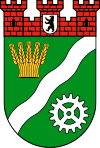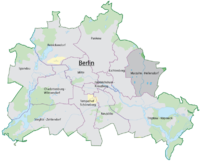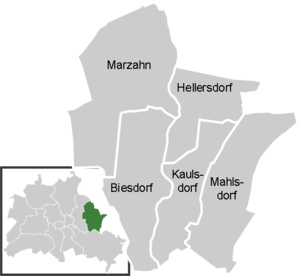- Marzahn-Hellersdorf
-
Arms Map 

Area: 61.74 km² Inhabitants: 248,264 (2010-03-31) Population density: 4,021 inhabitants per km² Website: official homepage Politics Mayor of Borough: Dagmar Pohle (The Left) Parliament of Borough BVV: The Left Party.PDS 22, SPD 15, CDU 7, Alliance '90/The Greens 3, FDP 3, NPD 3, WASG 2 (last election 2006) Map of the localities 
Marzahn-Hellersdorf is the tenth borough of Berlin, formed in 2001 by merging the former boroughs of Marzahn and Hellersdorf.
Contents
Geography
It is situated in the northeast of Berlin. Marzahn-Hellersdorf borders to the Berlin boroughs of Lichtenberg in the west and Treptow-Köpenick in the south as well as to the Brandenburg municipalities of Ahrensfelde in the north and Hoppegarten and Neuenhagen in the east.
Subdivision
The borough consists of five former villages which all became part of Greater Berlin in 1920:
- Biesdorf
- Hellersdorf
- Kaulsdorf
- Mahlsdorf
- Marzahn
History
Each of the five districts the borough consists of, originally came from one administrative district called "Landkreis Niederbarnim" and where incorporated into the city due to the establishment of Greater Berlin in 1920. Together with the two other boroughs Lichtenberg and Friedrichsfelde, they formed the borough Lichtenberg until 1979. At the end of the 1970s especially the district Marzahn grew as a result of the building of the developing area Marzahn. Consequently Marzahn was formed out of the five districts the borough consists of today in 1979.
As a result of the building of two more developing areas (Hellersdorf and Kaulsdorf) the number of inhabitants increased so that the borough Hellersdorf was founded out of the three districts Hellersdorf, Kaulsdorf and Mahlsdorf on 1 June 1986. The borough remained independent until 2001.
In view of whole Berlin, Marzahn-Hellersdorf shows the biggest changes concerning demography. In 1991 the average age of the two boroughs reached a number of 30,5 years which increased to 39,6 years due to the migration of the younger people.
Politics
Historically, the PDS (Party of Democratic Socialism) dominated politics in the borough of Marzahn-Hellersdorf. In 2001, the PDS garnered 51,1% of the vote in the elections for the borough assembly (Bezirksverordnetenversammlung), and captured four of the six seats on the borough council (Bezirksamt). In the 2006 borough assembly elections, the PDS won 38,2%; the SPD, 25%; the CDU, 13%; the Greens, 5,1%; the NPD, 6,4%; and the FDP 5% of cast ballots. The district Kaulsdorf/Mahlsdorf was won by the CDU; the remaining six were won by the PDS. Dagmar Pohle (PDS, now the Left Party) was elected as mayor of the borough (Bezirksbuergermeister), Stefan Komoss (SPD) is the deputy mayor. The five councilors on the borough council (Bezirksamt) are Christian Graeff (CDU), Stephan Richter (SPD), Manuela Schmidt (Left Party) and Norbert Luedtke (Left Party). Bernd Mahlke resigned his post as deputy mayor after a long bout of illness.
Twin towns
Marzahn-Hellersdorf has seven twin towns:
 Halton, England since 1993
Halton, England since 1993 Kastrychnitski district, Minsk, Belarus since 1993
Kastrychnitski district, Minsk, Belarus since 1993 Lauingen, Germany since 1999
Lauingen, Germany since 1999 Partyzanski district, Minsk, Belarus since 1993
Partyzanski district, Minsk, Belarus since 1993 XV. kerület (Rákospalota), Budapest, Hungary since 1991
XV. kerület (Rákospalota), Budapest, Hungary since 1991 Tychy, Poland since 1992
Tychy, Poland since 1992 IV. kerület (Újpest), Budapest, Hungary since 1992
IV. kerület (Újpest), Budapest, Hungary since 1992
External links
Coordinates: 52°32′23″N 13°35′03″E / 52.53972°N 13.58417°E
Districts and localities of Berlin  Charlottenburg-Wilmersdorf
Charlottenburg-Wilmersdorf Friedrichshain-Kreuzberg
Friedrichshain-Kreuzberg LichtenbergAlt-Hohenschönhausen • Falkenberg • Fennpfuhl • Friedrichsfelde • Karlshorst • Lichtenberg • Malchow • Neu-Hohenschönhausen • Rummelsburg • Wartenberg
LichtenbergAlt-Hohenschönhausen • Falkenberg • Fennpfuhl • Friedrichsfelde • Karlshorst • Lichtenberg • Malchow • Neu-Hohenschönhausen • Rummelsburg • Wartenberg Marzahn-Hellersdorf
Marzahn-Hellersdorf Mitte
Mitte Neukölln
Neukölln PankowBlankenburg • Blankenfelde • Buch • Französisch Buchholz • Heinersdorf • Karow • Niederschönhausen • Pankow • Prenzlauer Berg • Rosenthal • Stadtrandsiedlung Malchow • Weißensee • Wilhelmsruh
PankowBlankenburg • Blankenfelde • Buch • Französisch Buchholz • Heinersdorf • Karow • Niederschönhausen • Pankow • Prenzlauer Berg • Rosenthal • Stadtrandsiedlung Malchow • Weißensee • Wilhelmsruh ReinickendorfFrohnau • Heiligensee • Hermsdorf • Konradshöhe • Lübars • Märkisches Viertel • Reinickendorf • Tegel • Waidmannslust • Wittenau
ReinickendorfFrohnau • Heiligensee • Hermsdorf • Konradshöhe • Lübars • Märkisches Viertel • Reinickendorf • Tegel • Waidmannslust • Wittenau SpandauFalkenhagener Feld • Gatow • Hakenfelde • Haselhorst • Kladow • Siemensstadt • Spandau • Staaken • Wilhelmstadt
SpandauFalkenhagener Feld • Gatow • Hakenfelde • Haselhorst • Kladow • Siemensstadt • Spandau • Staaken • Wilhelmstadt Steglitz-Zehlendorf
Steglitz-Zehlendorf Tempelhof-Schöneberg
Tempelhof-Schöneberg Treptow-KöpenickAdlershof • Alt-Treptow • Altglienicke • Baumschulenweg • Bohnsdorf • Friedrichshagen • Grünau • Johannisthal • Köpenick • Müggelheim • Niederschöneweide • Oberschöneweide • Plänterwald • Rahnsdorf • SchmöckwitzDistricts > Localities > Zones • Greater Berlin Act • Former boroughsCategories:
Treptow-KöpenickAdlershof • Alt-Treptow • Altglienicke • Baumschulenweg • Bohnsdorf • Friedrichshagen • Grünau • Johannisthal • Köpenick • Müggelheim • Niederschöneweide • Oberschöneweide • Plänterwald • Rahnsdorf • SchmöckwitzDistricts > Localities > Zones • Greater Berlin Act • Former boroughsCategories:- Marzahn-Hellersdorf
- Districts of Berlin
Wikimedia Foundation. 2010.

